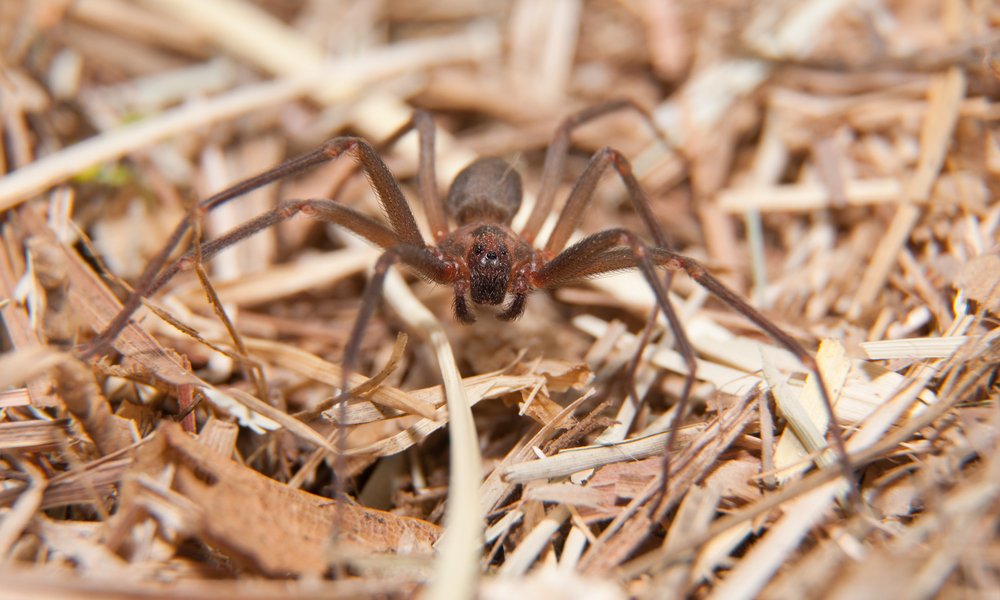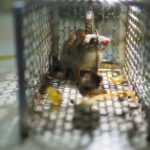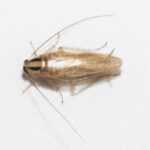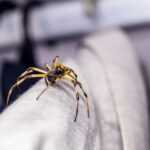Recluse Spider: Facts, Dangers & Prevention Tips
The recluse spider is a venomous spider whose bite can cause serious health problems. Identifying and understanding these spiders is crucial for safety. This article discusses how to recognize them, their habitats and behaviors, and offers prevention and first aid tips.
- Brown recluse spiders are identifiable by their violin-shaped marking, six eyes, and small size, making awareness of these features critical for avoiding bites.
- Effective prevention of brown recluse spider infestations includes sealing entry points, decluttering, and regular pest control measures.
- Serious systemic reactions or fatalities from brown recluse spider bites are extremely rare, providing reassurance that severe outcomes are uncommon.
- In the event of a bite, immediate first aid is essential, and medical attention may be necessary for severe reactions to ensure proper recovery.
Identifying Recluse Spiders
Identifying a brown recluse spider, scientifically known as Loxosceles reclusa, can be tricky due to its unassuming appearance. These spiders are typically brown with uniformly colored abdomens and no distinct patterns. One of the most recognizable features is a violin-shaped marking on their cephalothorax, though the clarity of this marking can vary. The violin pointing refers to the neck of the violin marking pointing toward the abdomen, which is a key identifying feature. Despite being known as violin spiders, not all brown recluses have this marking prominently displayed. The fused head and thorax form a single structure called the cephalothorax, which helps distinguish them from other spiders with separate head and thorax segments.
Another distinctive characteristic of Loxosceles reclusa is their eye arrangement. Recluse spiders are different from most spiders. Unlike the typical eight eyes, they have six eyes arranged in three groups of two, known as dyads. This arrangement—three groups of two—is a key identification feature that sets them apart from other brown-colored spiders. For example, funnel weaver spiders are sometimes confused with brown recluses, but funnel weavers have eight eyes arranged differently, making eye pattern a useful way to tell them apart. Their bodies are relatively small, usually not exceeding 3/8 inches in length, with long, slender legs that lack spines.
Understanding these key identifiers can help you distinguish brown recluse spiders from other spiders commonly found in homes. Positive identification is especially important in the context of spider bites, as collecting and preserving the specimen can ensure proper diagnosis and treatment. While their appearance might not be striking, these subtle features are crucial for successful brown recluse control and avoiding potential bites.
Habitat and Distribution
Recluse spiders thrive in dry, warm environments, and their preferred habitats reflect this. Outdoors, they are often found in undisturbed areas such as caves, rock piles, logs, and woodpiles. Indoors, they have adapted to living indoors, especially in areas with poor ventilation or clutter, often hiding in attics, basements, crawl spaces, wall voids, and behind furniture. These spiders favor cluttered areas, making storage containers, storage boxes, cardboard boxes, and closets ideal hiding spots. Brown recluse spiders often rest in hidden locations such as behind furniture and inside storage containers. Removing bed skirts can help reduce hiding spots for these spiders.
The distribution of brown recluse spiders is primarily in 16 states across the United States, with a significant presence in the southeastern and south-central regions. This geographical concentration means that residents in these areas should be particularly vigilant. Wall voids are important harborage areas for brown recluse spiders, so inspecting and sealing these spaces is recommended. Understanding where these spiders commonly reside can help in taking proactive measures to prevent infestations.
By recognizing their favored habitats and distribution, you can better prepare your home to avoid unwanted encounters. Regular inspections and cleaning of these areas can significantly reduce the likelihood of stumbling upon a brown recluse.
Behavior and Habits
Brown recluse spiders are nocturnal hunters, preferring to venture out at night in search of food. The brown recluse’s hunting behavior involves actively stalking and capturing prey rather than relying on webs. During the day, they remain hidden in dark brown, secluded areas, which makes spotting them a challenge. Unlike some other spiders, the brown recluse’s web-building habits involve creating irregular retreats made of silk strands, not typical cobwebs. These silk strands form hidden locations where they wait for the opportune moment to hunt. Spiders walk with a distinctive, active running movement, and the brown recluse’s tendency to move quickly and hide in small spaces influences how easily they are detected.
Despite their fearsome reputation, brown recluse spiders are not aggressive. They typically bite only when they feel threatened or are unintentionally pressed against. This can happen when moving furniture, putting on clothes, or reaching into storage areas. Although they are solitary creatures, under the right conditions, large groups can sometimes be found in close proximity, and they are rarely bitten.
Familiarity with their behavior and habits helps mitigate risks. Knowing when and where they are most active allows you to take steps to protect yourself and keep these spiders out of sight.
Life Cycle and Reproduction
The life cycle of brown recluse spiders begins with the female producing several egg sacs during the summer. Each egg sac is a small, sticky silken structure in which the female lays and guards her eggs until they hatch into spiderlings. This protective behavior ensures that a new generation of spiders can safely enter the world.
After the eggs hatch, the spiderlings go through a series of molts, typically five to eight times, before reaching adulthood. This maturation process takes about 10 to 12 months. Knowledge of their life cycle aids in planning effective control measures, especially during the breeding season when their population can increase rapidly.
Medical Significance of Bites
The bite of a brown recluse spider can vary in severity, but it is always a cause for concern. Symptoms may include:
- reddened skin
- blisters
- necrotic ulcers
- pain
- itching
- burning sensation
The severity of a brown recluse spider bite depends on the amount of venom injected and the individual’s sensitivity. In most cases, symptoms are mild, but more severe symptoms like necrosis are rare and typically occur in less than 10% of cases.
In more severe cases, the bite can lead to rapid destruction of red blood cells, and the venom can damage underlying tissues, resulting in necrotic wounds and ulceration. A severe reaction may cause significant tissue damage, long healing times, and, in rare instances, life-threatening complications. Chest pain may also occur in rare, severe cases, especially in vulnerable populations such as children and older adults.
While most brown recluse bites heal within three weeks, some may take months to fully recover. The potential for severe symptoms, such as necrosis and systemic reactions, makes it crucial to seek medical attention if bitten. Although a brown recluse bite is infrequently reported, their potential impact on health cannot be overlooked.
Given the seriousness of these bites, understanding their medical significance and prompt action can substantially affect outcomes. Awareness and readiness are your best defenses against the dangers posed by these spiders.
First Aid for Recluse Spider Bites
Bites occur most often when the brown recluse spider is disturbed or trapped against the skin, such as when putting on clothes or moving stored items.
If you suspect you’ve been bitten by a brown recluse spider, immediate first aid can mitigate the severity of the reaction.
Here are the steps to follow:
- Start by applying an ice pack to the bite area to reduce swelling.
- To prevent infection, clean the wound thoroughly with soap and water.
- After that, apply an antibiotic ointment.
- Elevating the affected area can also help reduce swelling.
In cases where the bite leads to necrosis, medical treatment may involve the removal of dead tissue. Hyperbaric oxygen therapy is another potential treatment for significant tissue damage. Early and appropriate first aid can significantly improve recovery outcomes.
Quick action with these first aid steps can significantly affect how the body responds to the venom. Preparedness and information are key in handling the repercussions of a brown recluse spider bite.
Preventing Infestations
Preventing brown recluse spider infestations starts with making your home less inviting to these pests. Use caulking, screens, and weather stripping to seal small gaps around windows and doors, and ensure that cracks and crevices are sealed to prevent spiders access to hiding spots. Improving attic and crawl space ventilation can also deter these spiders from settling in. Regularly decluttering closets and storage rooms will eliminate potential hiding places for many spiders. Store items in plastic bags instead of cardboard boxes to further reduce hiding spots.
Additionally, cleaning up dead insects will remove food sources for spiders. When cleaning and decluttering, remember these steps help control many spiders, not just brown recluses. Place sticky traps in strategic locations to monitor and control spider populations. Outdoor preventive measures include eliminating woodpiles, leaf litter, and rocks to reduce potential habitats. Regular pest control services can detect early signs of infestations and take proactive measures, such as applying residual pesticides to cracks and voids, to kill individual spiders and prevent them from becoming established.
Implementing several control methods together—such as sealing entry points, using sticky traps, decluttering, and applying residual pesticides—can significantly reduce the chances of encountering brown recluse spiders in your home. Consistent effort and vigilance maintain a spider-free environment.
Effective Spider Control Methods
An integrated pest management strategy is essential for effectively managing brown recluse spider populations. Professional pest control servicesconduct detailed inspections to identify hiding spots and entry points. They use several control methods, including both chemical and non-chemical approaches, tailored to the specific needs of the infestation.
Chemical treatments, including pyrethroids like cyfluthrin and cypermethrin, as well as residual pesticides, are effective for controlling recluse spiders through direct contact and providing long-term control in cracks, voids, and other hiding spots. Non-chemical methods such as vacuuming, sanitation, harborage removal, and the use of sticky traps are essential to reduce spider populations and monitor activity. While a fly swatter can be used to kill individual spiders, it is often ineffective due to the spiders’ fast and elusive nature. Professional control increases the likelihood of long-term effectiveness in managing these spiders.
Combining these methods achieves successful brown recluse control and ensures your home remains safe from these potentially dangerous spiders.
Professional Help
When dealing with indoor infestations of recluse spiders, it is recommended to consult a professional pest management company. Professionals offer thorough inspections and effective treatments to address your pest problems. Utilizing flushing agents, they can locate breeding areas of recluse spiders and provide targeted solutions. This expertise and ongoing support make a significant difference in maintaining a safe and comfortable living environment.
Understanding recluse spiders, their habits, and the potential dangers of their bites is essential for anyone living in areas where these spiders are prevalent. By identifying them correctly, knowing their habitats, and implementing effective prevention and control methods, you can protect yourself and your home. If an infestation occurs, professional help from trusted services like Gopher Patrol can ensure a thorough and effective resolution. Stay informed, prepared, and proactive to keep your living spaces safe from these elusive creatures.
Frequently Asked Questions
What does a recluse spider look like?
The brown recluse spider is light brown with a distinctive violin-shaped marking on its back, just behind its eyes. This identifying feature becomes more pronounced as the spider matures.
What states do brown recluse spiders live in?
Brown recluse spiders are found in sixteen states across the southern and central Midwest, including Alabama, Georgia, Texas, and Missouri. Their range extends from southeastern Nebraska to southwestern Ohio and down to north Georgia.
What happens when you are bitten by a brown recluse spider?
A brown recluse spider bite can lead to symptoms like redness, blistering, and significant pain within hours, potentially progressing to tissue necrosis and open sores. It’s essential to seek medical attention if you suspect a bite to manage these serious symptoms effectively.
What attracts brown recluse spiders in the house?
Brown recluse spiders are attracted to homes with abundant small bugs, as they are their primary food source. Reducing insect populations can help make your home less inviting to these spiders.
How can I identify a brown recluse spider?
To identify a brown recluse spider, look for its uniform brown color and a distinct violin-shaped marking on the cephalothorax, along with six eyes arranged in three pairs. If you notice these characteristics, it’s crucial to exercise caution, as they can be venomous.





